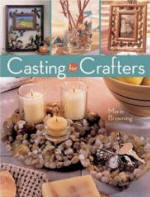 Review by Review by
Richard SumrallThe dictionary defines cast or casting as
"to form (liquid metal, for example) into a particular shape by pouring into
a mold." In her book "Casting for Crafters," designer and author Marie
Browning describes the different methods of casting and the procedure of
"pouring a material into a mold, letting it cure, then unmolding it ... to
create projects for your home and garden and to make gifts."
Casting is an ancient technology that had its origins in early
Mesopotamia. Among the earliest examples are their clay molds that were used
to cast copper bowls. The process of casting consists of three fundamental
steps: gathering the necessary supplies, creating the mold and applying the
correct techniques to a particular casting material or substance.

The supplies that you need will depend on your choice of the casting
material used to create the mold. Although molds can be formed from numerous
materials, Browning recommends that the master mold be made from an
oil-based clay. These clays are available at arts and crafts stores and are
easier to form and manipulate. From this master mold you can then create
your casting mold. The casting mold can be constructed from polymer clay,
sand or rubber. Each of these materials has its own advantages. Polymer clay
is easy to use, captures detail and is desirable when casting small objects.
Sand is one of the oldest casting materials and is used to cast metals and
flat relief pieces. Rubber is a versatile material that also captures the
extreme detail of a piece and is the preferred choice for casting
three-dimensional objects. Once you become comfortable with your molding
preferences you can experiment with the other kinds of molds described by
Browning. These include specialty plastics or specialized rubbers (natural,
synthetic, latex or silicone).
[to top of second column]
 |

The remainder of the book is devoted to techniques and projects
using clear castings, plaster castings or cement castings. There are
over 50 projects in the book; each project contains a list of the
supplies, tools and materials needed as well as a step-by-step
explanation of the manufacture of the crafted object. Key steps in
the creation process are accompanied by a color photographic
illustration. An attractive color photograph of the finished project
is also included.
As an added bonus Browning offers a brief section on hypertufa.
Hypertufa is defined as "the synthetic version of tufa rock, a
spongy rock found in limestone quarries and along coastlines." It is
the perfect casting substance to create planters and containers that
have the natural, rugged look that is appealing in garden settings.
The book's projects range from the simple and elegant to the
advanced and extraordinary. The "Fish Paperweight" is a wonderful
toy goldfish suspended in clear resin and requires only two pouring
steps and two finishing steps. The "Inspiration Plaque" is created
from an oil-based clay and is perfect for the home or workplace.
There are eight different items used for the mold plus three acrylic
paints, an antiquing glaze and a metallic paste. Although the
six-step process and the nine-step cast and decorate process make
this one of the book's more difficult projects, the finished object
(as shown in a beautiful color photograph) is spectacular.
"Casting for Crafters" is recommended to anyone interested in
learning or perfecting the art of casting.
[Richard Sumrall,
Lincoln Public
Library District]
 |